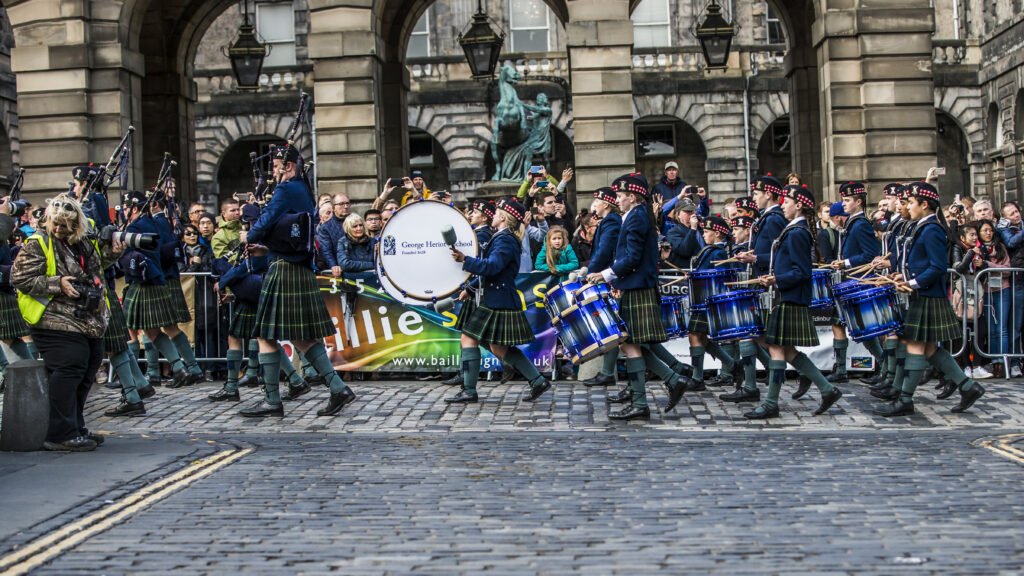Fear God and honour ye King with a long lyffe and prosperous reign and we shall ever pray to be faithful for ye defence of his sacred Majesty’s royal person till death
The Blue Blanket was personally inscribed by the Queen with a saltire, a thistle, an imperial crown and the words above
The Blue Blanket is the name of the Edinburgh Tradesmen’s Banner and is the affectionate name for the “Standard Of The Crafts Within The Burgh of Edinburgh”. Its early history is bound up in so much mythology that it is difficult to sift the actual facts from the fiction but this Standard is still held in great honour and reverence by the people of Edinburgh today. Legend has it that the blanket was presented to the craftsmen of Edinburgh by King James III in 1482 after they rescued him from Edinburgh Castle, where he’d been imprisoned for 9 months, but there is no authentic document of the period that records the supposed event.
It is also said to have been carried as the battle flag of the Edinburgh Trades at the Battle of Flodden in 1513, when a large number of craftsmen died defending it and their king. The tattered remains of the Banner are reputed to have been brought back to Edinburgh the next day by Randolph Murray, Captain of the Guard, and handed over, with the dreadful tidings of the defeat of the Scottish army and the death of the King.


The Blue Blanket, c. 1661, is made of silk and is believed to have been a bright azure blue in colour. It is too fragile to be removed from its case and is no longer blue; over the centuries it has faded to a pale greyish brown. It measures ten feet, two inches long and six feet six inches wide and now hangs in the museum of artefacts, kept behind glass for safekeeping in the museum of artefacts of the Incorporated Trades in Edinburgh, under the care of the Deacon Convenor Of The Incorporated Trades of Edinburgh. In 2012 a new version was made for ceremonial use and it has appeared in Edinburgh on several occasions. It is waved from the platform of the Mercat Cross every year at the Edinburgh Riding of the Marches and it is carried in solemn procession at the Kirking of the Deacons. In 2014 it was carried from the Church of the Greyfriars at the head of the procession which went to the spot where Mary Erskine lies buried, for the Incorporated Trades to pay respect to her memory as their principal benefactor.
The conditions that came with ownership of the Blue Blanket were two fold. Should the banner be unfurled, the Deacon Convenor Of The Trades will be granted an audience with the Monarch. The Blanket could also be raised to summon all the craftsmen of Scotland to fight in support of the Monarch. This happened in September 1513 with disastrous consequences.

The first definite reference to the Blue Blanket in a historical document occurs in 1543, at the beginning of the reign of Mary, Queen of Scots. In that year is was raised in the Council Chamber by the Deacons of the Incorporated Trades, who were protesting against encroachments on their privileges and deprivation of their ancient rights.
This very old painting of the Blue Blanket being carried by the Edinburgh Captain behind the Queen as she enters the Cannongate Kirk, is hung in No. 8 Journeymen Masons Lodge in Blackfriars Street. As tradesmen, Masons hold the flag in the highest esteem as do other ancient trades such as the Guild of Hammermen.
James VI mentions it in his idiosyncratic book, The Basilikon Doron. In the first edition, published in 1599, he wrote: “And the Craftes-men thinke wee should bee content with their worke, howe bad and deare so ever it bee; and (if they in anie thing bee controlled) up must the blewe-blanket goe.”
Subsequent editions alter the wording to read: “And the Craftes-men thinke we should be content with their worke, howe bad and deare so ever it be: & if they in any thing be controlled, up goeth the blew-blanket.”




